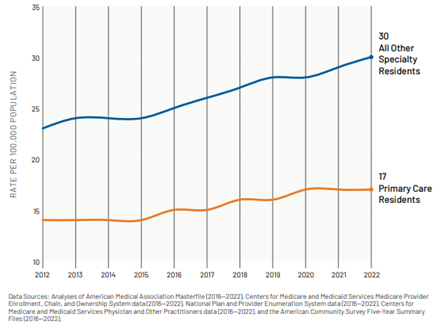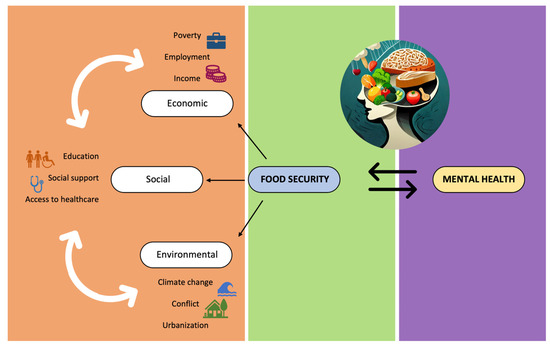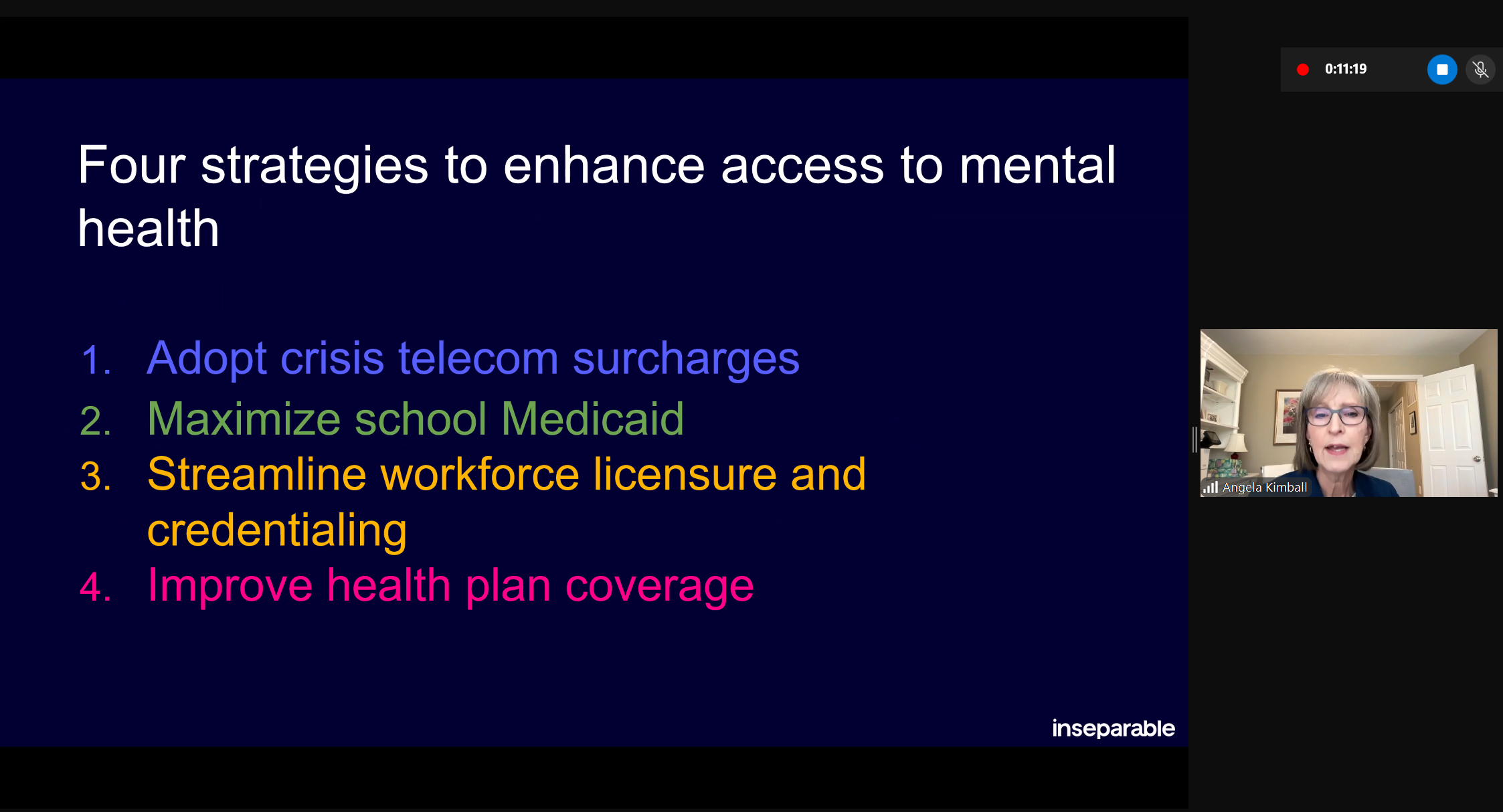The public sector plays a key role in advancing skills-based strategies, driven by gubernatorial leadership. Whether in the early stages or more advanced in their adoption of skills-based policies and practices, states and territories continue to innovate and evaluate these shifts.
(Download)
Skills-based hiring transforms talent acquisition by prioritizing a candidate’s skills, competencies, and relevant work experience over traditional qualifications like degrees or job titles. This approach addresses two significant limitations of traditional hiring methods: the risk of poor job fits when degrees are the primary filter, and the narrowing of the candidate pool when degree or specific title requirements are rigidly enforced. While skills-based hiring can add complexity to the hiring process, it offers significant benefits, including better job matches, reduced turnover, and increased job satisfaction. Additionally, it promotes career mobility and fosters a more inclusive workforce, which can, in turn, positively impact the broader economy.
State and territory governments have emerged as leaders in this transformation, with many enacting legislation or executive orders to remove degree requirements and prioritize skills and experience. This shift not only opens broader talent pools but also addresses workforce shortages and promotes diversity and inclusion. Early evidence shows that states adopting skills-based policies see a higher proportion of job postings without degree requirements, which can increase accessibility to public sector jobs for individuals with non-traditional backgrounds. Governments have a strong incentive to lead this change, given the significant supply gaps in critical public sector roles. As the workforce ages and labor force participation declines, the need to attract skilled workers becomes even more urgent. Expanding skills-based hiring can help bridge these gaps, improve job fits, and enhance public services. States and territories that lead by example in skills-based hiring can catalyze broader adoption in both public and private sectors, potentially impacting millions of jobs across the U.S. Several states, including Maryland, Colorado, Pennsylvania, and Massachusetts, have already made significant strides in removing degree requirements, with positive outcomes such as reduced vacancy rates, increased application numbers, and improved job fit. These examples highlight how skills-based hiring can be operationalized in state government and the public sector. As states continue to build on this momentum, skills-based hiring is poised to become a model for other employers seeking to attract and retain a more diverse, skilled, and adaptable workforce.
Key Findings on Skills-Based Initiatives in State and Territory Governments:
- Over half of U.S. state governments have adopted policies encouraging skills-based hiring, including eliminating degree requirements for many job postings.
- States that have embraced skills-based hiring saw faster growth in job postings that don’t require degrees compared to states without such policies.
- These policies are helping states address talent shortages, diversify their workforce, and improve hiring outcomes.
- Challenges remain, including the need for robust data, new assessment tools, and adequate funding to support these initiatives.
- States that adopt skills-based hiring and talent management strategies can enhance workforce mobility and better match talent to public sector needs.
For skills-based hiring to have a meaningful, lasting impact, it’s essential to adopt a proactive approach focused on measurement and analysis. Collecting and analyzing data, along with providing transparent outcome evaluations across agencies, are key steps in maintaining momentum and fostering continued support for skills-based strategies. As state and territory governments continue to lead the way, their example can set the stage for broader adoption across other sectors, helping to address workforce shortages, improve public services, and create a more inclusive economy.
Introduction
Skills-based hiring aims to identify the specific knowledge, abilities, and competencies that a candidate possesses and evaluate whether they match what is needed for an open role. This a shift away from the traditional way of evaluating candidates based on the colleges they attended, the degrees they earned, and the job titles they have held.
Skills-based hiring highlights two major flaws with traditional hiring practices. First, inferring a candidate’s competence based on a college attended, degree earned, or job held can result in a bad fit between the candidate and the work that needs to be performed. Second, requiring that candidates attend some set of schools, earn some set of degrees, or hold specific prior jobs dramatically limits the pool of candidates that employers can consider for their vacancies. While certain roles, such as attorneys and medical professionals, will continue to require specific degrees or certifications due to licensure requirements, many public sector positions can greatly benefit from a skills-based hiring approach
But skills-based hiring is not without its own challenges – evaluating skill level and skill fit adds time to the hiring process for both candidates and employers, and existing application systems remain oriented around traditional degree-based hiring. Nonetheless, employers that overcome these challenges can achieve better hiring outcomes: improved matches between candidates and jobs, lower turnover, and higher job satisfaction. And more broadly, greater adoption of skills-based hiring can facilitate career advancement and mobility for the worker, which is productive for the economy overall.
The shift towards skills-based hiring is underway, but progress is uneven. Studies such as those conducted by the Burning Glass Institute reveal a decline in degree requirements for middle-skill and high-skill occupations in the years of the Covid-19 pandemic but only modest movement away from degree-based hiring among some of the large companies that committed to skills-based hiring during those years. But even modest progress underscores some recognition among employers that skills are predictive of job readiness and performance.
One promising area of progress is with one of America’s largest employers: state governments. More than half of state and territory governments have enacted legislation or executive orders that advance skills-based hiring, often by removing degree requirements where possible and prioritizing a holistic review of candidates’ prior work experience and non-degree credentials, as well as degrees. State governments understand that removing strict educational requirements can help them access a broader pool of candidates, allowing individuals with the necessary skills, to obtain employment. This action bridges skill gaps and can help employers reach those who many not have been part of their workforce in the past. Because Governors are dedicated to fostering upward economic mobility, they are natural champions for these hiring practices.
What’s more, the legislation and executive orders promoting skills-based hiring are changing hiring behavior. In the years following legislation or executive orders, 22 of the 25 state and territory governments that enacted these changes saw their share of job postings without a degree increase faster than in states and territories that have not promoted skills-based hiring.

If action within state and territory governments can catalyze broader action within the public sector, as many as 22.0 million jobs could be affected, or 14.1% of U.S. jobs. Even limiting to public administration roles – i.e., executive branch agencies and departments but not public hospitals, education institutions, or the military – leadership at this level could affect 10.4 million jobs, or 6.7% of U.S. jobs, according to Lightcast data. The reach of these employers goes even further when considering government contractors and other private employment that is supported through government spending and procurement.
States have a compelling reason to change their hiring practices to access a larger talent pool. Research by Lightcast, in collaboration with organizations that represent public sector professionals (such as public finance roles) highlights significant supply gaps and hiring challenges. Similarly, Revelio Labs has described a hiring crisis in state and local government. This hiring challenge is likely to intensify: Lightcast’s study on workforce demographics shows 27% of state government jobs and 26% of local government jobs (excluding education and hospital jobs) are held by workers 55 or older. Rising Baby Boomer retirements and declining labor force participation, among other factors, will result in a deficit of six million workers by 2032 across the public and private sectors.
To harness the full potential of skills-based hiring and mitigate staffing shortfalls, state and territory governments can continue to lead by example. By expanding skills-based hiring, states and territories not only address critical workforce shortages but also cultivate a more dynamic, diverse, and adaptable public sector workforce. And by improving the skill fit between workers and the jobs they fill, they improve public services as well. With momentum building, the shift to skills-based hiring within state and territory governments offers a model for other employers in the public or private sectors. This report provides an overview of the initial actions taken by state and territory governments to implement skills-based hiring and talent management strategies through changes in policy and practice. It examines the impacts of these changes, highlighting both successes and challenges, and offers a set of strategic recommendations and metrics for state and territory governments to monitor progress and assess the effectiveness of skills-based policy and practice adoption.
Skills-Based Hiring at State and Territory Governments: Early Actions
More than half of U.S. states have issued policy directives centered around skills-based hiring. In 25 of those states and 1 territory, the policies directed state government hiring entities to re-evaluate their own job requirements, prioritizing skills and a holistic evaluation of prior work and credentials earned instead of simply requiring a degree.
With at least a year of job posting data from 16 states, it was found that 13 states with skills-based hiring policies saw an increase in jobs that didn’t require a degree, compared to states without such policies.
Skills-based policies were administered by state and territory governments during 2021-2024, contributing to an uptick in job postings omitting a degree requirement between 2021-2023. In 2024, there was a backslide in skills-based hiring. In the private sector, the types of occupations in demand during the Covid-19 pandemic increased the share of job postings that did not list a college degree requirement – for example, truck drivers, warehouse workers, and customer service workers hired as business shifted towards online and delivery modes. In the years since, as the types of occupations in demand have returned to pre-Covid-19 characteristics, the share of jobs requiring a degree has increased slightly but there has been a lasting shift away from degree requirements.
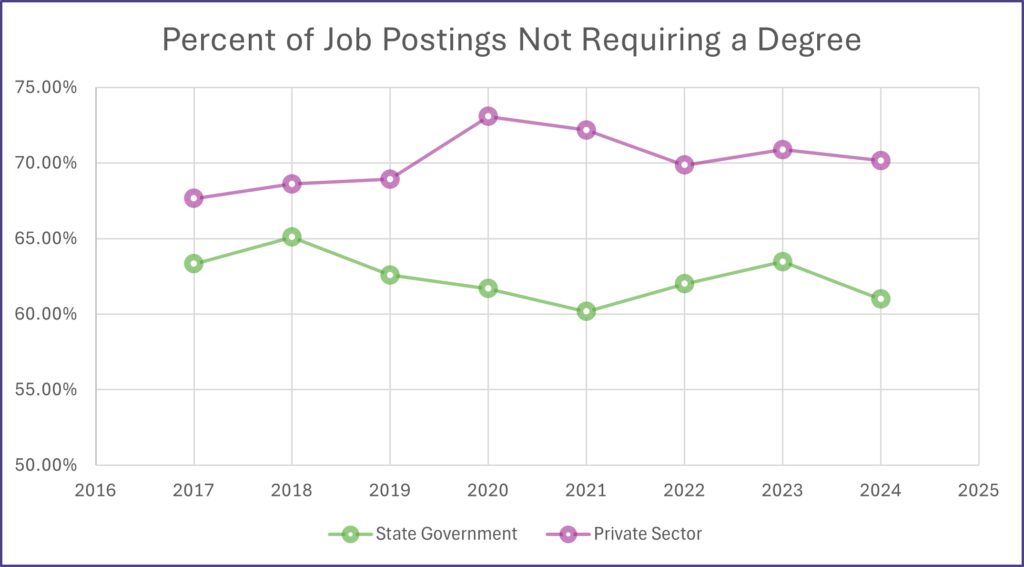
Despite policy changes, there are inherent challenges in helping applicants without degrees secure full-time public sector employment. Several potential reasons exist to explain the challenges:
- Initiatives to increase access for non-degree-holding workers are extremely recent. Although some states have been experimenting with skills-based hiring for some time, many only removed degree requirements within the past year. The earliest state policy actions to remove degree barriers date only to 2022 and implementation is still in progress.
- Many states lack the foundational data necessary to improve systems that identify talent. Building systems that measure the skills and learning of workers without college degrees requires new foundational data derived from their experiences and learning. This includes developing standardized job descriptions and metrics for evaluating on-the-job effectiveness to better define and identify high-quality talent. Given many states have just begun their process of identifying skills needed for various roles, many do not yet have these systems in place.
- The shift to skills-based hiring can be more costly, and progress can be limited without adequate funding. By removing barriers like degree requirements, the size of the talent pool expands and increases the volume of applicants requiring screening and assessment. This volume can strain HR and candidate screening capacity and increase associated costs. Skills-based hiring initiatives also come with various other costs, including re-drafting job descriptions, conducting job analyses, building assessments to validate skills, training HR teams and hiring managers on new skills-based processes, updating technology, and creating new training programs to build skills such as internships and apprenticeships.
- States do not currently have processes to understand, expand, and audit skills-based talent practices. States need to develop strategies to approve and use skills-based job descriptions, understand how candidates move through the hiring system, and how workers with non-traditional backgrounds or those without degrees are supported to be effective and promoted. Close monitoring of all these metrics can lead to better functioning skills-based talent processes.
- Creating a culture that embraces skills-based initiatives is necessary. Removing degree requirements from job postings does not mean hiring managers will no longer prioritize candidates with a degree when making hiring decisions. Creating a culture that embraces the practice of skills-based initiatives at all levels is crucial alongside the development of metrics to track practice change.
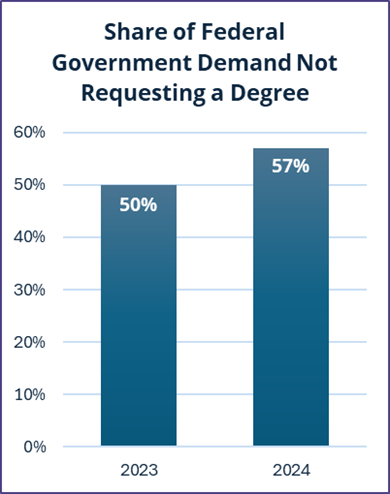
An Early Analysis Of Skills-Based Hiring Impacts
To address talent shortfalls, the public sector is undergoing a transformation in how it views and assesses talent. Federal and state initiatives are taking significant strides in promoting skills-based hiring strategies, underscoring a commitment to modernize the recruitment landscape. The federal government is transitioning to full skills-based hiring and actively expanding early career pathways that do not require a four-year degree. In June 2020, a federal executive order was issued to replace degree-based criteria with skills and competency-based hiring in the federal civil service. The Office of Personnel Management (OPM) was tasked with reviewing degree requirements for federal job postings within six months. In January 2023, Congress passed the Chance to Compete Act, making skills-based hiring a legal requirement for federal agencies, and by the end of 2024, more than 70% of the federal workforce was in positions that did not have a degree requirement.
In addition, the Office of Personnel Management (OPM) has launched flagship skills-based assessment programs such as SMEQA (Subject Matter Expert Qualification Assessments) and has significantly grown the use of OPM’s online assessment platform – USA Hire – from just 18 USAJOBS announcements using USA Hire assessments in 2011 to over 20,000 in 2024. New guidance from OPM has further promoted the use of skills-based approaches, including the Skills-Based Hiring Guidance and Competency Model for Artificial Intelligence Positions, which assists agencies in identifying the key skills and competencies needed for AI professionals and the joint OMB-OPM M-24-16 Memorandum that prioritize creating, updating, and utilizing skills-based and multi-hurdle assessments to align with leading practices and transition away from using solely self-assessment questionnaires. OPM is also transitioning the 2210 IT Management job series, which covers over 100,000 technical positions—ranging from product managers, software developers, cybersecurity practitioners, and AI specialists—to be fully skills-based.
Early career pathways into federal service that do not require four-year degrees also promote skills-based recruiting and hiring. Former President Biden’s signing of the Executive Order on Scaling and Expanding the Use of Registered Apprenticeships, continues the investment in apprenticeships and recent updates to OPM’s signature early career talent program, Pathways, has expanded eligibility for the Pathways Internship and Recent Graduates Programs to include those with or without formal degrees who have completed “qualifying career or technical education programs” which may include Registered Apprenticeship Programs, Job Corps, AmeriCorps, and Peace Corps.
Public sector skills-based hiring continued to build momentum through gubernatorial action, beginning with an executive order from the Governor’s office in Maryland. In 2022, the state dropped bachelor’s degree requirements from the majority of public sector job descriptions. Between 2022 and 2024, the share of Maryland state government job postings not requiring a degree increased from 32% to 47%.
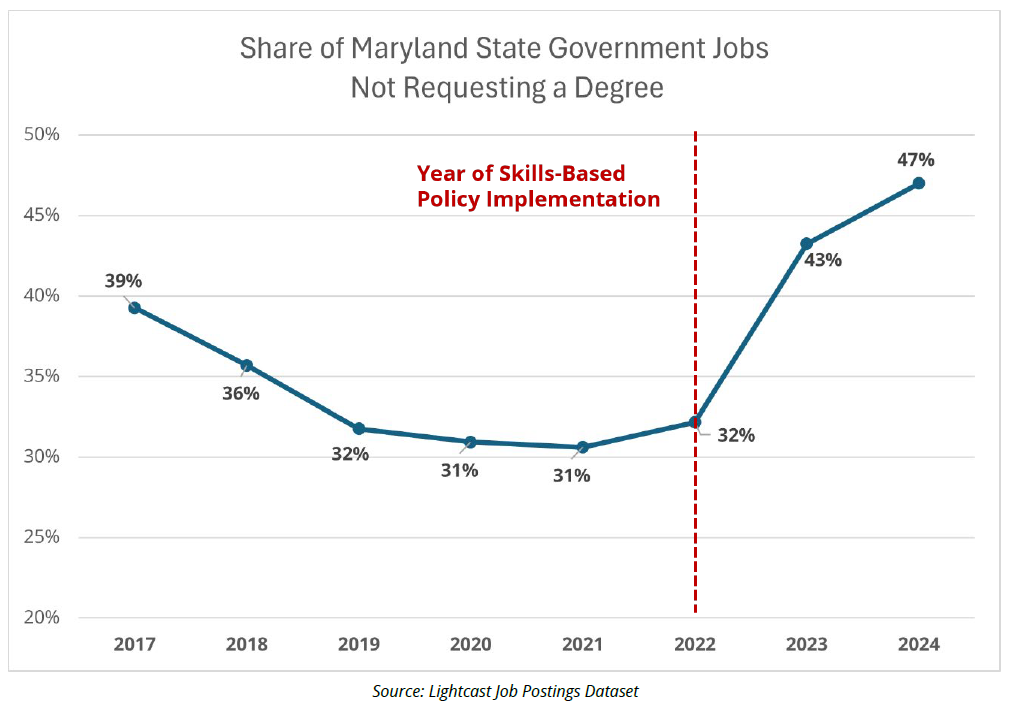
Colorado has been testing skills-based practices since 2019 to create a workforce that mirrors its populace, achieve hiring goals in a competitive job market, and tackle future talent challenges. In 2022, Governor Polis issued an executive order for the state’s transition to skills-based hiring. Following this, he signed another order to enhance work-based learning and apprenticeship in state government. Together, these orders reflect a major shift from traditional degree-focused talent strategies to emphasize hiring, development, and retention based on workplace skills. By 2025 the state aims to remove unnecessary degree requirements from all eligible jobs and facilitate the creation of two work-based learning programs at each state agency. To operationalize skills-based hiring across the state, Colorado is modernizing its state-sponsored labor exchange, ‘Connecting Colorado.’ The new technology will analyze skills based on job descriptions and applicant resumes. This will ensure that state job postings reflect the most up-to-date skills and help potential candidates better understand their skill sets, ultimately leading to improved candidate-position matching.
Between 2022-2024, the share of Colorado state government job postings not requesting a degree increased from 48% to 58%.
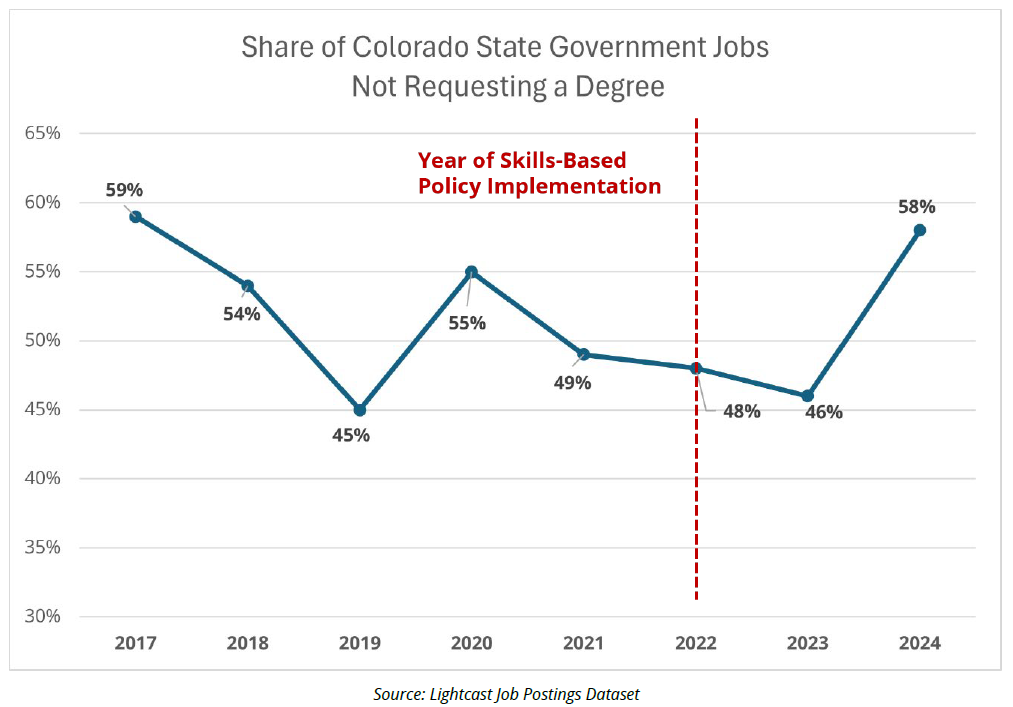
Pennsylvania Governor Josh Shapiro issued an executive order on his first day in office in 2023 removing four-year degree requirements from roughly 92 percent of positions in state government – opening up approximately 65,000 jobs to a wider pool of candidates. As a result, almost 60% of new hires do not have a college degree.
Over the last few years, Delaware has implemented a strategy aimed at increasing hiring and making state jobs more accessible. As part of this initiative, the Delaware Department of Human Resources (DHR) reviewed hiring practices, including reevaluating the degree requirements for hundreds of state positions. The bachelor’s degree requirement was removed for roles in the Family Service Specialist, Human Resource Advisor, State Human Resource Analyst, and Probation and Parole Officer classifications, replacing it with relevant work experience. This change led to several positive outcomes:
- Family Service Specialist positions saw a 6% reduction in vacancy rates, a 575% increase in applicants, and a 13% decrease in non-qualified applicants.
- Human Resource Advisor and State Human Resource Analyst roles experienced a 7% reduction in vacancy rates in 2023 and a 4% reduction in 2024, with applications increasing by 9% and non-qualified applicants dropping by 13%.
- Probation and Parole Officer positions achieved a 0% vacancy rate in 2023 and a 7% vacancy rate in 2024, with an 18% increase in applications and a 48% decrease in non-qualified applicants.
Along with DHR’s comprehensive review of job requirements, the state implemented a targeted marketing campaign, increased salaries, and introduced innovative signing and retention bonuses for hard-to-fill roles. These efforts contributed to record hiring years in 2022 and 2023, with 2024 on track to be another year of exceptional hiring.
In March 2024, Puerto Rico’s government introduced an innovative pilot plan aimed at revamping talent acquisition and management through artificial intelligence. This initiative was designed to create an agile and flexible recruitment system capable of attracting and retaining top talent. The plan incorporated a skills-based management strategy that focuses on enhancing employees’ development and growth opportunities. With this move, Puerto Rico leads as the first within the US state and local public sectors to officially implement a skills-based AI-driven talent management strategy. This pilot is a component of a larger Civil Service Reform, aiming to enhance human capital capabilities and resources in Puerto Rico’s government.
In January of 2024, Governor Healey of Massachusetts signed an executive order directing state agencies to institute skills-based hiring as part of the “Lead by Example” Employer Talent Initiative, to expand talent pools and create a more inclusive skilled workforce. As part of this work, Massachusetts has delivered on three key initiatives in 2024.
- Created an online skills-based hiring toolkit, which includes multiple resources for hiring managers, and a video message from Governor Healey.
- Developed and assigned mandatory training to 8,000+ managers and supervisors, on how to implement skills-based hiring practices, with simple and practical examples and exercises for reducing bias, crafting job descriptions, recruitment planning, and more. And, they have
- Participated in the MassSkills Coalition, a group of statewide public and private employers, committed to exploring and implementing skills-first talent management strategies.
Between 2019 and 2024, the share of Massachusetts state government job postings not requesting a degree increased from 26% to 34%.
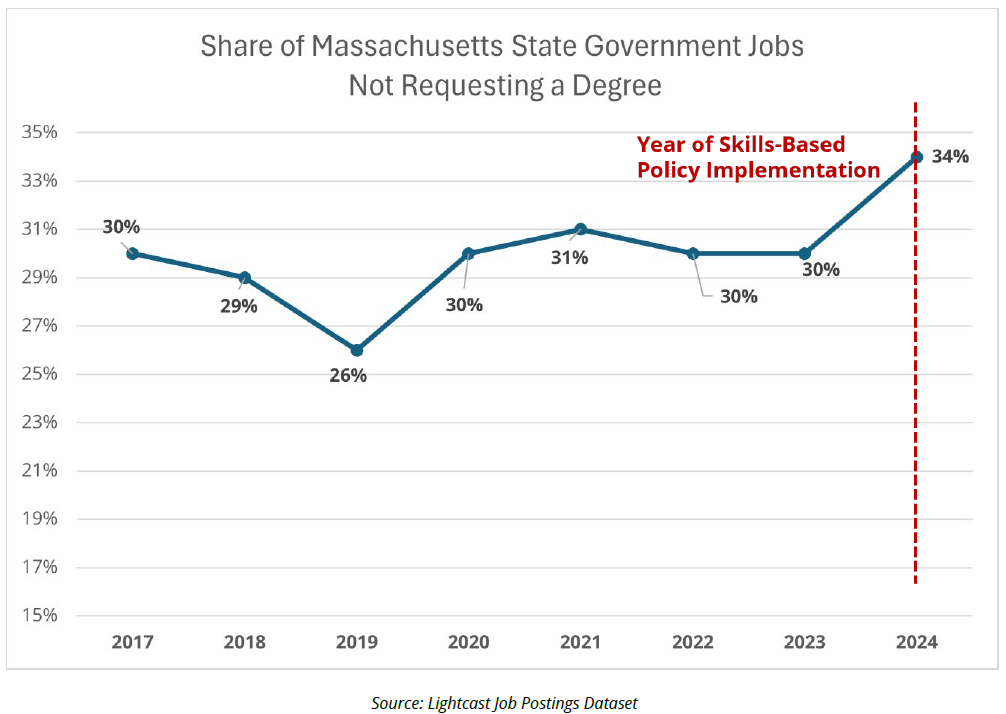
Ohio Governor Mike DeWine’s executive order in October 2023 established Ohio as a leading employer for skills-based hiring. Since then, Ohio has created a statewide skills-based hiring policy, reviewed state job classifications and where applicable, revised education requirements to emphasize experience or skill qualifications, and developed a skills-based search function that allows applicants looking for state government positions to locate openings based on their specific experiences, skills, and training, not just academic degrees. Additionally, the Department of Administrative Services hired a liaison to coordinate efforts with career technical schools across the state to create pathways into public service through work-based learning experiences.

By early 2024, 25 states made similar pledges to remove degree requirements through executive orders, legislation, and administrative actions. Of states that implemented skills-based policies, the ten with the largest increase in percent of job postings omitting a degree are shown in the table below.
| State Government Employer | 2019 | 2024 | Change 2019-2024 |
|---|---|---|---|
| Virginia Government | 58% | 90% | 1.5x increase |
| Maryland Government | 36% | 52% | 1.4x increase |
| Tennessee Government | 27% | 39% | 1.4x increase |
| Massachusetts Government | 26% | 34% | 1.3x increase |
| Colorado Government | 45% | 58% | 1.3x increase |
| Alaska Government | 62% | 77% | 1.2x increase |
| Idaho Government | 65% | 76% | 1.2x increase |
| South Dakota Government | 55% | 64% | 1.2x increase |
| Utah Government | 65% | 74% | 1.1x increase |
| North Carolina Government | 54% | 59% | 1.1x increase |
Metrics To Track Skills-Based Talent Strategy Progress
Skills-based strategies can improve every stage of the talent management process. Talent management requires organizations to assess their current workforce needs, size those needs against what is available internally, and develop a plan to fill the gap that remains. An important element of a skills-based talent management strategy is to fill gaps , through regular upskilling and professional development, clear career pathways, detailed performance evaluations, cross-functional exposure, and a focus on retention and advancement. Where workforce needs cannot be met internally, organizations can look to recruit and hire talent. Whether looking externally or internally, organizations can take a skills-based approach.
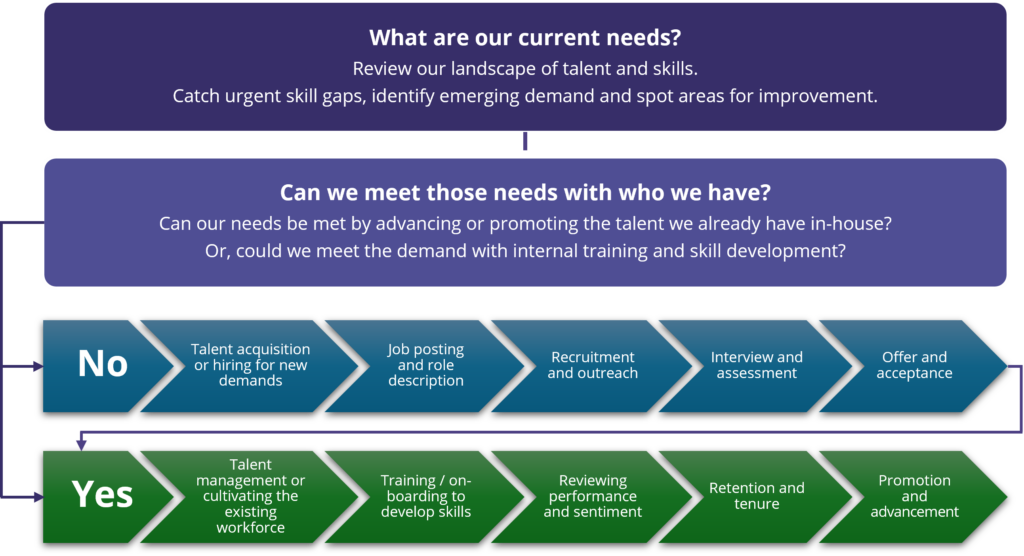
Employers should use metrics to track the effectiveness of skills-based strategies. The strategies and metrics that follow map the stages of talent management in the graphic above.
Talent Acquisition
Talent acquisition refers to the process of finding new employees. It encompasses several key stages: creating job postings and role descriptions that clearly define the skills and competencies required for the position, outreach and recruitment efforts aimed at reaching a diverse and qualified candidate pool, evaluating candidates through interviews and other assessments, and concluding with an offer and acceptance. The strategies and metrics below describe a skills-based approach to talent acquisition.
(1) Job Postings and Role Descriptions
Strategies:
- Emphasize skills and competencies required for a role, rather than educational qualifications.
- Reduce or remove degrees that take multiple years to complete, where possible.
- Use consistent language across job postings and role descriptions, such that candidates reviewing multiple open positions develop a sense for where their skills best apply.
- Limit the requested characteristics to those essential to the role, to avoid candidates opting out of applying because they do not meet all criteria.
- Invite candidates to signal competency in a variety of ways – a degree, where necessary, as well as non-degree credentials, relevant prior experiences, or a portfolio or example of past work.
- Use inclusive language to encourage applicants from diverse educational and professional backgrounds – for example, “open to non-degree candidates with relevant experience or certifications.”
- Detail the potential for growth and career advancement within the role, as well as the opportunities for skill development within the organization.
Metrics:
- Percentage of job postings that do not require a degree.
- Percentage of job postings that include inclusive language, such as explicitly inviting candidates without a degree to apply.
- Percentage of job postings that offer a variety of ways to signal competency, such as non-degree credentials, prior experiences, or a portfolio or example of past work.
- Employee satisfaction with role descriptions and job postings, measured through feedback from hiring managers and employees staffed in similar roles.
(2) Recruitment and Outreach
Strategies:
- Recruit via multiple channels, specifically those that emphasize targeted skill development – technical boot camps, trade schools, online learning platforms, adult education centers, as well as colleges and universities.
- Train recruiters to effectively convey how skills acquired through non-traditional pathways—such as military service, parenting, community involvement, or volunteer work—are relevant to a given role.
- Start or expand apprenticeships, internships, or other work-based learning programs.
- If using staffing firms, incentivize them to increase the number of candidates without traditional postsecondary experience.
- If using employee referrals, encourage referrals from employees without traditional postsecondary experience.
Metrics:
- Total number of applicants.
- Number and type of recruitment channels used for recruitment and outreach.
- Number and share of applicants through the channels that are not colleges or universities. (Exclude job boards or direct online applications where it is difficult to attribute the recruitment channel.)
- Share of applicants that do not have a degree applying for roles that do not request a degree.
- Number of individuals who move through apprenticeships, internships, or other work-based learning programs.
- The rate of conversion between work-based program participants and full-time employment within the state agency or department.
(3) Interviews and Assessments
Strategies:
- Having received applications, invite candidates without formal postsecondary experience to interview.
- Implement skills assessments as part of the evaluation process to test the candidate’s ability to perform the required tasks. These could include coding tests, case studies, or simulations.
- Use structured interviews that focus on past experiences demonstrating skills and problem-solving abilities. Invite candidates to explain how to transfer skills from previous experiences to a current role.
- Use scoring rubrics to objectively evaluate candidates based on the skills they have demonstrated during assessments.
Metrics:
- Share of candidates without formal postsecondary experience invited to interview.
- Percentage of candidates given skill assessments, structured interviews, and scored via a standardized rubric.
- Candidate satisfaction with the evaluation process.
- Hiring manager satisfaction with the evaluation process.
(4) Offer and Acceptance
Strategies:
- Communicate potential opportunities for career advancement on track with the role that a candidate is being offered.
- Offer development opportunities to new hires based on their skill level and growth potential.
- Introduce the onboarding process and the steps that the new hire will undergo to be able to perform at a high level in the new role.
Metrics:
- Number and share of job offers and hires made to candidates without a degree.
- Offer acceptance rate for candidates hired for the roles that have utilized the skills-based strategies detailed above.
- Compare the share of candidates without a degree invited to interview (the “top of the funnel”) to the share of candidates without a degree hired (the “bottom of the funnel”).
- Track demographic changes in hiring (e.g., gender, race, socioeconomic background) to determine if skills-based strategies are helping to diversify the state workforce.
- Track metrics on populations that the state has identified as key talent opportunity groups (ex. Veterans, individuals with disabilities, justice-involved) to assess if skills-first strategies have any impact on the diversity in the talent pool.
Talent Management
Talent acquisition refers to the process of finding new employees. It encompasses several key stages: creating job postings and role descriptions that clearly define the skills and competencies required for the position, outreach and recruitment efforts aimed at reaching a diverse and qualified candidate pool, evaluating candidates through interviews and other assessments, and concluding with an offer and acceptance. The strategies and metrics below describe a skills-based approach to talent acquisition.
(1) Training and Onboarding
Strategies:
- Tailor onboarding to individual employees’ skills and background, especially if they are coming from a non-traditional pathway.
- Pair new hires with mentors who can guide them in learning new skills or honing existing skills, as well as with navigating organizational culture.
Metrics:
- How long it takes new hires to be fully productive in the new role, based on milestones or performance targets.
- Rate of completing training, or retention rate through onboarding process.
- New hire satisfaction with onboarding.
(2) Performance Reviews
Strategies:
- Assess employees based on competencies and skills demonstrated, not just task completion.
- Implement regular, real-time feedback loops where employees receive input on how they can improve or expand their skills or apply those skills to the job.
Metrics:
- Track the progress of skill development using self-assessments and/or manager assessments.
(3) Retention and Tenure
Strategies:
- Offer ongoing skills training and development programs to help employees acquire new skills, stay competitive, and feel valued in their roles.
- Recognize employees not just for time spent in the company but for the skills they have developed and how they contribute to the organization’s success.
- Expose employees to work in other agencies or departments through cross-functional collaboration, which might expand how employees envision their career pathways within the organization.
Metrics:
- Track the percentage of employees who actively engage in training or skills development programs, correlating this with retention trends.
- Track the percentage of employees who stay with the company over a given period, disaggregated by whether they participated in skill development programs.
- Monitor turnover among employees with critical skills or in critical roles to determine if skills development programs reduce attrition in these areas.
(4) Promotion and Advancement
Strategies:
- Set clear promotion criteria based on skills and competencies, ensuring employees are promoted based on their ability to perform the required tasks at a higher level.
- Encourage internal mobility by offering employees the opportunity to transfer to other roles or departments where they can apply and develop new skills.
- Provide leadership training that focuses on both technical and soft skills necessary for higher-level roles.
Metrics:
- Compare rates of promotion to the assessment of skill performance in manager and self evaluations.
- Track how many employees in leadership development programs successfully complete their training and transition into leadership roles.
Monitoring and Improvement
Establishing skills-based practices begins with identifying leadership. Leadership can be a government function, department, or individual responsible for implementing strategies that enhance skills-based talent acquisition and talent management. The National Governors Association’s Skills in the States Initiative highlights the varying structures of hiring functions across states—centralized or diffuse.
Centralized agencies can quickly implement talent strategies, while those with more decentralized structures may better understand talent distribution and growth opportunities. Regardless of governance, effective leadership and accountability are essential for advancing skills-based practices.
The strategies and metrics described above relate to the ongoing HR activities of bringing in new employees and ensuring that they are contributing and satisfied. Infusing these activities with a skills-based approach requires additional work from leadership. These responsibilities are detailed below.
(1) Ensure that the additional cost (time and resources) of hiring using skills-based strategies is offset by positive employment outcomes.
- Measure the time-to-hire rate of roles leveraging skills-based practices and compare them to the time-to-hire rate for roles requiring degrees. Compare employee performance, turnover rates, and manager and employee satisfaction in roles hired using skills-based approaches and roles hired using traditional means. If skills-based approaches take longer to yield a match, ensure that they yield improved matches between candidates and jobs, lower turnover, and higher job satisfaction.
- Collect feedback from hiring managers on the skills-based hiring process and the performance and overall job fit of candidates hired under the new policy. Assess how the hiring process has changed in terms of efficiency, candidate pool diversity, fit for the role, career pathway progression, and retention.
- Track career progression of employees without a degree hired through skills-based practices. Measure whether employees hired through skills-based practices are being promoted and how their career progression compares to degree-holding employees.
(2) Provide active updates to senior leaders and sponsors, such as Governors.
- Share progress through regular reports. Identify the audience for progress reports on skills-based strategies- including the governor’s office, relevant state legislative committees, and agency leadership. Create quarterly or annual reports that evaluate the progress of skills-based hiring implementation at state agencies. Include data on hiring outcomes, employee performance, budgetary impacts of skills strategies, and training updates.
- Compare the state’s progress with other states with similar HR regulatory structures or private sector employers who have adopted skills-based practices. Identify areas for improvement or best practices that can be adopted from other successful initiatives from the public or private sector.
- Connect skills-based hiring initiatives to other workforce priorities. Analyze the impact of skills-based strategies on occupational areas of critical shortage in the public sector workforce.
(3) Train HR staff in new policies and monitor the implementation of these policies.
- Develop and deploy skills-based hiring training and talent management sessions for HR staff and hiring managers to ensure they are supported . This step ensures consistency across all agencies in terms of understanding and applying the skills-based hiring process:
- How to create job descriptions based on skills, not degrees.
- How to assess candidates for skills during interviews and screening.
- How to input data accurately into tracking systems (e.g., indicating which candidates were selected based on skills).
- How to onboard new employees hired under skills-based practices.
- How to communicate the value proposition for skills-based hiring.
- How to embrace skills-based initiatives through change management that facilitates a skills-inclusive culture
- Track the percentage of hiring managers and human resources staff who have been trained in skills-based hiring and talent management practices.
- Collect feedback from hiring managers on the skills-based hiring process and the performance and overall job fit of candidates hired under the new policy. Assess how the hiring process has changed in terms of efficiency, candidate pool diversity, fit for the role, career pathway progression, and retention.
- Measure the accuracy of skill assessment results to applicant skill profiles for new applicants recruited under skills-based hiring. Compare accuracy and role alignment to prior hires converted outside of skills-based hiring processes.
- Measure the skill assessment results of incumbent workers in their current roles to understand skill alignment and outline potential career advancement or upskilling opportunities.
- Track the retention of work-based learning participants and compare them to the overall retention rates within that agency or enterprise-wide depending on the design.
(4) If skills-based policies yield positive results for state governments and their workforces, share those results with the public and key stakeholders, and monitor public sentiment.
- Over time, survey the public to assess whether perceptions of accessibility to state jobs have changed because of skills-based policies.
- Track how many individuals have learned about the new hiring practices through these campaigns and how many applied as a result.
- Conduct constituent satisfaction surveys with agencies fully implementing and operationalizing skills-based strategies to determine the satisfaction or improvement of business operations and/or service delivery impacts of skills-based hires.
- Engage with education providers, training institutions, and workforce development programs to gauge their perception of how state hiring practices have shifted and if there’s increased opportunity for the individuals they serve.
Creating An Action Plan For Implementation
To effectively shift towards skills-based hiring in the public sector, state leaders should establish clear and actionable strategies for collecting and utilizing these skills-focused metrics and tracking key outcomes. In addition to tracking how well implementation is going using the metrics outlined above, state agencies can create a data evaluation plan to ensure that state agencies can systematically gather, analyze, and apply this data. This transition from defining metrics to operationalizing their collection requires careful planning, coordinated effort across agencies, and the development of tools aligning with organizational goals and regulatory standards. By devising a thoughtful implementation plan that incorporates these elements, states can not only capture essential data but also build consistent and fair hiring practices that prioritize candidate skills. This strategic approach can enhance the quality of hires to cultivate a more diverse and capable workforce. The following steps can help states plan and carry out these steps.
Set clear goals and objectives.
- Define the goals of the skills-based hiring policy shifts for the state. For example:
- Increase the diversity of candidates hired by focusing on skills rather than degrees.
- Improve workforce efficiency by hiring based on competency.
- Broaden the applicant pool by removing unnecessary degree requirements.
- Fill critical shortage roles to support agency operations.
- Identify key metrics (from the earlier sections) that align with these goals.
- Assign agency/individuals who will be responsible for gathering data aligned to goals and metrics.
Establish a baseline.
Collect baseline data on current hiring practices before implementing the skills-based policy.
- Current Hiring Data: Number of job postings that require degrees vs. skills.
- Workforce Demographics: Existing diversity (educational, racial, gender) among current employees.
- Hiring Outcomes: Time to hire, employee retention rates, and performance evaluations under traditional hiring methods.
- Highest Need Positions: Roles that are experiencing critical shortages that should be prioritized in the implementation of state hiring innovation.
Develop or update data collection systems.
- Centralize data collection: Ensure all agencies use a standardized set of metrics/definitions for collecting and reporting hiring and retention data.
- If an Applicant Tracking System (ATS) is already in place, work to ensure it can capture skills-focused metrics, such as skill names and proficiency levels for reach.
- Develop a state-level skills database to track the competencies and qualifications of employees, alongside degree tracking.
- Ensure alignment: Provide guidelines, support, and training for state agencies on how to categorize and track applicants based on skills, experience, and certifications in addition to degrees.
By beginning with clear goals, state leaders can lay a solid foundation for their efforts in enhancing the public sector workforce. Collecting baseline data allows for a comprehensive understanding of the current landscape while establishing consistent processes for tracking both the adoption of skills-based strategies and the resulting outcomes ensuring accountability and adaptability. Measuring the impact of these skills-based talent processes opens the door to myriad positive economic opportunities for a diverse range of workers. It also serves to clearly demonstrate the efficacy of government operations. By assessing the capacity to find, engage, develop, and retain talent, Governors can effectively gauge how well the government fulfills its core responsibilities to the constituents it serves.
Conclusion
The public sector plays a key role in advancing skills-based strategies, driven by gubernatorial leadership. Whether in the early stages or more advanced in their adoption of skills-based policies and practices, states and territories continue to innovate and evaluate these shifts. As these skills-based strategies evolve, they promise to make public sector jobs more accessible to everyone, creating pathways for enhanced career mobility. This transformation could shift the employment landscape into one brimming with opportunities. Additionally, by attracting individuals with innovative perspectives and fresh ideas, these strategies can drive significant improvements in service delivery across government functions. Achieving these meaningful impacts necessitates a proactive mindset focused on measurement and analysis. Identifying key areas for growth, capturing vital data, and providing transparent outcomes measurements across state agencies are essential steps that can inspire continued commitment and enthusiasm for skills-based talent strategies.
Acknowledgements
This report was made possible through the generous support and partnership of Walmart, with data analysis provided by Lightcast, a leading labor market analytics firm.
We would also like to extend our gratitude to the following leaders for their valuable feedback on the “Metrics to Track Skills-Based Talent Strategy Progress” section of this report.
- Matt Walsh and Josh Wright, Lightcast
- Erin White, Business Roundtable
- Sharon Leu, Jobs for the Future (JFF)
- Amanda Welsh, Northeastern University
- Soumya Korde and Tori Kendrick, Grads of Life
- Lauren Day, Boston Consulting Group
- Christina Curnow and Gauri Rege, American Institutes for Research
- Jason Tyszko, US Chamber Foundation
- Stuart Andreason, Burning Glass Institute
Additionally, we would like to thank NGA’s Skills in the States Community of Practice, Advisory Council, and Data Sub-Committee for providing valuable feedback, insights, and early learnings on the impacts of skills-based initiatives.
Disclaimer
The research included in this report was made possible through funding by Walmart. The findings, conclusions and recommendations presented in this report are those of the National Governors Association alone, and do not necessarily reflect the opinions of Walmart.



